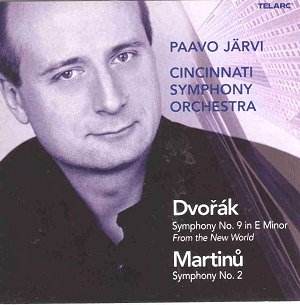As Paavo Jarvi points
out in his brief foreword to Kyle Gann's
liner note, both these symphonies were
premiered in the USA. Both works involve
their composer's recalling a distant
homeland with all the poignant longing
that comes from separation.
I am not at all sure
about Järvi’s Dvořák
9. Often in the first movement the music
seemed effortful with accenting and
points being made in a laboured way
as at 4.30. By contrast Järvi brings
out every ounce of pathos from the Largo.
The brusque Beethovenian gesture at
the start of the clamant molto
vivace registers very strongly.
While little mannered gestures may momentarily
distract (1:40) overall this movement
works well. The finale is both dramatic
and sprightly. There is much here to
enjoy but I would not prefer this in
the face of the versions by Kondrashin,
Kubelik and Kertesz.
The first five of Martinů’s
six symphonies were written in quick
succession during the years of his wartime
exile to the USA. The Second arose from
a commission by a group of Czech
expatriates. It was premiered by Erich
Leinsdorf and the Cleveland Orchestra
on 26 October 1943 in the same
concert as the premiere of the Lidice
Memorial (recently superbly done
by Conlon on Capriccio).
The Second Symphony
is certainly lyrical. Its singing heart
is in the andante moderato but
there is also a skippingly commedia
dell'arte element most clearly in
the springy poco allegro third
movement and in the finale. The buzzy-busy
music of the finale reflects the composer’s
wild and woolly neo-classical forays
in Paris. However what we hear in this
symphony more often than not reminds
us that here is the same composer who
in a couple of year’s time was to write
the Fourth Symphony.
Järvi's No. 2
is as ebullient and lively as his father's
version on Bis. Comparison's with the
recordings by Flor, Neumann, Thomson
and Kuchar are not really appropriate
given the coupling. Those others are
all-Martinů
discs. The Telarc disc is the only CD
to presents the Martinů 2 alongside
Dvořák 9.
Here
is a not untroubled but still effective
Dvořák 9 alongside a very good
Martinů 2. Congratulations all
round on thoughtfully provocative programming.
Rob Barnett
footnote
Rob:
I hope you don't mind me commenting
on a detail in your interesting review
of the recent Telarc CD of Dvorak 'New
World' and Martinu Symphony No 2 on
MusicWeb International.
You write about Symphony No 2: 'It
was premiered by Erich Leinsdorf and
the Cleveland Orchestra on 26 October
1943 in the same concert as the premiere
of the Lidice Memorial (recently superbly
done by Conlon on Capriccio).'
From what I've seen in other references
the works were premiered on the same
day but not at the same concert - the
Lidice performance was in New York conducted
by Artur Rodzinski. The date is given
as October 28, Czech National Day. Martinu
and his wife attended the Cleveland
concert.
I've recently heard the Telarc CD and
your comments seem to me just right.
Best wishes,
MARK TODD


